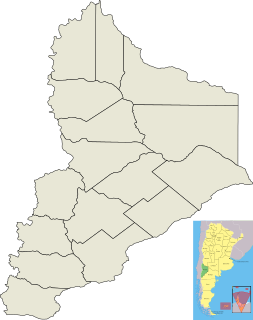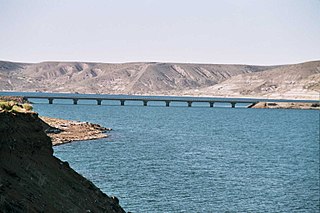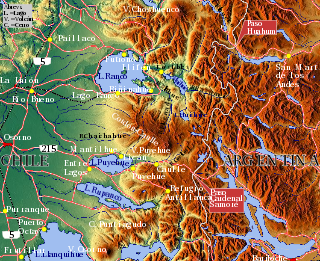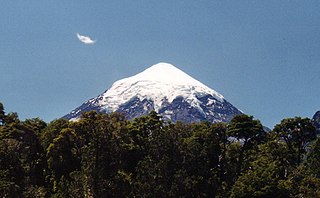 W
WThe Agrio River is a river of Argentina. The river starts in the Andes Mountains and eventually joins the Neuquén River.
 W
WAguada San Roque is a village and municipality in the Añelo Department of the Neuquén Province in southwestern Argentina.
 W
WThe Aluminé River is a geographical feature of Neuquén Province, Argentina. It flows southward from Lake Aluminé, near the town of Aluminé, for around 170 km (105 mi), past which it becomes a tributary of the Collón Curá River.
 W
WArroyito is a village and municipality in Neuquén Province in southwestern Argentina. It is located 54 km south of the city of Neuquén, at the junction of National Route 22 and National Highway 237. Arroyito has 81 inhabitants, representing an increase of 68.75% in ten years compared to the previous census with 48 inhabitants.
 W
WBajada del Agrio is a village and municipality in the Picunches department in Neuquén Province in southwestern Argentina. It is located on the Agrio River, a tributary of the Neuquén River, 60 km north of Zapala through Provincial Route (RP) 14, is also close to the RP 10 and RN 40.
 W
WBarrancas (Neuquén) is a village and municipality in Neuquén Province in southwestern Argentina.
 W
WButa Ranquil is a village and municipality in Neuquén Province in southwestern Argentina.
 W
WCardenal Antonio Samoré Pass is one of the main mountain passes through the southern Andes along the border between Argentina and Chile.
 W
WCaviahue-Copahue is a village and municipality in Neuquén Province in southwestern Argentina.
 W
WCentenario (Neuquén) is a village and municipality in Neuquén Province in southwestern Argentina.
 W
WChapelco, or Cerro Chapelco, is a mountain and massif in Neuquén Province, south-western Argentina. The ski station of the same name is located 19 kilometres (12 mi) from the resort town of San Martín de los Andes.
 W
WThe Chimehuin River is a river in the northwest of the Patagonic Province of Neuquén, Argentina. Its origin is at Lake Huechulafquen and it passes by the city of Junín de los Andes. After a course of about 53 km, it merges with the Aluminé River to form the Collón Curá River.
 W
WThe Cochiquito Volcanic Group is a small volcanic group of volcanoes north of the town of Buta Ranquil in Argentina. The main peak is Volcán Cochiquito, a stratovolcano of estimated Pleistocene–Holocene age. There are eight satellite cones in the volcanic field, including Volcán Sillanegra and Volcán Ranquil del Sur.
 W
WThe Collón Curá River is a geographical feature of Neuquén Province, Argentina. It flows southward from the confluence of the Aluminé and Chimehuin Rivers, near the town of Junín de los Andes, for around 70 kilometres (43 mi), past which it becomes a tributary of the Limay River. The Collón Curá Formation and in turn the South American land mammal age Colloncuran are named after the river.
 W
WComahue is a sub-region of Argentina slightly to the south of the country's centre that covers the northern part of Argentine Patagonia and includes the provinces of Neuquén and Río Negro. Some also include La Pampa Province and the Patagones Partido at the southern tip of Buenos Aires Province.
 W
WThe Correntoso River is a river located in Villa La Angostura, Argentina. This river runs from Correntoso Lake to Nahuel Huapi Lake, standing out as one of the shortest rivers in the world, with between 200 and 300 m in length. This river is famous among the fishing enthusiasts, due to the abundance of large trouts, especially at the mouth of Nahuel Huapi Lake.
 W
WCuyín Manzano is a village and municipality in Neuquén Province in southwestern Argentina.
 W
WThe Domuyo Volcano is a stratovolcano located in the Argentine province of Neuquén. With a height of 4,702 m (15,427 ft), it is the highest mountain in Patagonia and is sometimes called the "Roof of Patagonia".
 W
WEl Cholar is a village and municipality in Neuquén Province in southwestern Argentina.
 W
WEpulafquén Lake is a lake in Neuquén Province, Patagonian Argentina. This glacial lake is located in the Andean mountains in Lanín National Park. Hydrologically it forms one lake together with Huechulafquen Lake and is then considered an arm of it. It is separated from Huechulafquen Lake by a small channel formed due to the emergence of a small volcanic cone during the Holocene. One if the lake's most prominent features is a large delta-formed lava flow from Huanquihue volcano on its southern shore.
 W
WEspejo Lake is a lake of glacial tectonic origin located in southern Neuquén Province, Argentina. The lake lies near the town of Villa La Angostura, on the route known as the Road of the Seven Lakes.
 W
WGuañacos is a village and municipality in Neuquén Province in southwestern Argentina.
 W
WHua Hum Pass is an international mountain pass in the Andes between Chile and Argentina. The pass takes its name from the Hua Hum River that flows from Argentina into Chile at the site of the border crossing. Even though the pass does not go through the continental divide, it crosses the highest peaks of the cordillera.
 W
WThe Huahum River is a river in southern Chile and Argentina. It drains the waters of Lácar Lake in Argentina to Pirihueico Lake in Chile. The river gives name to Huahum Pass, an international mountain pass on the border between Chile and Argentina.
 W
WHuinganco is a village and municipality in Neuquén Province in southwestern Argentina.
 W
WJunín de los Andes is a village in the province of Neuquén, Argentina. It has 10,592 inhabitants at the 2001 census [INDEC], and is the head town of the Huiliches Department. It is located in the south of the province, by the Chimehuin River, on National Route 234, about 35 km (22 mi) north of San Martín de los Andes and 17 km (11 mi) from the Chapelco Airport, which services the area. In spring and summer, it's a famous place for birdwatching, fishing and also climbing the nearest volcano called Lanin.
 W
WLa Buitrera (Neuquén) is a village and municipality in Neuquén Province in southwestern Argentina.
 W
WLácar Lake is a lake of glacial origin in Neuquén Province, Argentina. It is enclosed in the Andes mountain range, at 630 m above mean sea level. The area around the lake is mostly uninhabited, except for the city of San Martín de los Andes on its northeastern coast. The lake has a surface area of 55 km² and a mean depth of 167 m, with a maximum of 277 m. Its catchment basin comprises 1,048 km². Like many Andean Argentine lakes, it drains across Chile and into the Pacific Ocean, in this case via the Huahum River that flows through Huahum Pass in the Andes. As the northernmost lake on the eastern side of Andes that drains to the Pacific the lake and its catchment basin were claimed by Chile until 1902 based on an interpretation of the Boundary treaty of 1881 between Chile and Argentina. The lake, along with the smaller lake nearby, Lolog, has some sacred significance for the Mapuche people, as it features in their oral tradition as part of a creation myth.
 W
WLanín National Park is a national park of Argentina, located in the Neuquén Province, with forests of diverse tree varieties, mainly Fagaceae and conifers such as the lenga and the Araucaria, many species of which are not found elsewhere in Argentina.
 W
WLas Coloradas is a third category municipality and capital city of the Catán Lil Department, located in Neuquén Province, Argentina.
 W
WLos Catutos is a village and municipality in Neuquén Province in southwestern Argentina. It is located in the center of the province, 20 km from the department capital, Zapala.
 W
WLos Miches is a village and municipality in Neuquén Province in southwestern Argentina.
 W
WManzano Amargo is a village and municipality in Neuquén Province in southwestern Argentina.
 W
WMari Menuco is a village and municipality in Neuquén Province in southwestern Argentina.
 W
WMariano Moreno (Neuquén) is a village and municipality in Neuquén Province in southwestern Argentina.
 W
WMinas is a department located in the north of Neuquén Province, Argentina.
 W
WOctavio Pico is a village and municipality in Neuquén Province in southwestern Argentina.
 W
WOnce de Octubre is a village and municipality in Neuquén Province in southwestern Argentina.
 W
WCerro Pantojo is an extinct basaltic stratovolcano on the border of Argentina and Chile. It lies immediately south of Cardenal Antonio Samoré Pass and its characteristic spire-shaped summit is an eroded volcanic plug. It also has flank lava flows.
 W
WPaso Aguerre is a village and municipality in Neuquén Province in southwestern Argentina.
 W
WThe Pichachén Pass is a pass over the Andes mountains that connects Argentina and Chile. The border crossing between Argentina and Chile is at 2,060 m (6,760 ft) AMSL.
 W
WPehuenches is a department located in the west of Neuquén Province, Argentina.
 W
WPino Hachado Pass is a mountain pass through the Andes, joining Chile and Argentina. It is one of the principal passes of the southern Andes, connecting Argentina's route RN-22 and Chile's Route 181-CH.
 W
WPlaza Huincul is a small city in Neuquen province, with a population of around 13,000 people, located in southwestern Argentina. It is approximately 1,288 km (800 mi) south-west from the capital, Buenos Aires. Plaza Huincul is located in the middle of the desert and grew thanks to an oil discovery in the area in 1918.It is said that the largest fossils in the world are found there; for example, the Argentinosaurs.
 W
WPrimeros Pinos is a village and municipality in Neuquén Province in southwestern Argentina.
 W
WPuesto Cortaderas is an isolated basaltic pyroclastic cone in Neuquén Province, Argentina.
 W
WQuili Malal is a village and municipality in Neuquén Province in southwestern Argentina.
 W
WRamón M. Castro is a village and municipality in Neuquén Province in southwestern Argentina.
 W
WSanto Tomás (Neuquén) is a village and municipality in Neuquén Province in southwestern Argentina.
 W
WSauzal Bonito is a village and municipality in Neuquén Province in southwestern Argentina.
 W
WTaquimilán is a village and municipality in Neuquén Province in southwestern Argentina.
 W
WTraful Lake is a lake in the Los Lagos Department of the Argentine province of Neuquén with an area of 76 km². The lake is the starting point of the Traful River that empties into the Nahuel Huapi Lake. It is contained inside Nahuel Huapi National Park.
 W
WThe Traful River is a river in Argentina. It flows from Traful Lake to Limay River.
 W
WTricao Malal is a village and municipality in Neuquén Province in southwestern Argentina.
 W
WTromen is a stratovolcano in western Argentina. It rises above the older caldera of the Volcán Negro del Tromen.
 W
WVarvarco is a village and municipality in Neuquén Province in southwestern Argentina. During the final stages of the independence wars Varvarco, located in indigenous territory, became the main base of the royalist Pincheira brothers, a royalist outlaw gang. More than a hideout the operations of the Pincheiras and their indigenous allies efectively turning Varvarco into a large town with 2000 Chilean women and 40,000 heads of cattle grazing in the nearby countryside.
 W
WVilla Curí Leuvú is a village and municipality in Neuquén Province in southwestern Argentina.
 W
WVilla Traful is a hamlet of the Argentine province of Neuquén located at the shore of the Traful Lake, at 720 metres above mean sea level. It is located inside the Nahuel Huapi National Park on the Road of the Seven lakes, 60 km from Villa La Angostura and 100 km from Bariloche, at 40°40′S 71°24′W. The main access is Provincial Route 65. The town was founded in 1936 by the Argentine National Park Administration (DPN).
 W
WVista Alegre (Neuquén) is a village and municipality in Neuquén Province in southwestern Argentina.